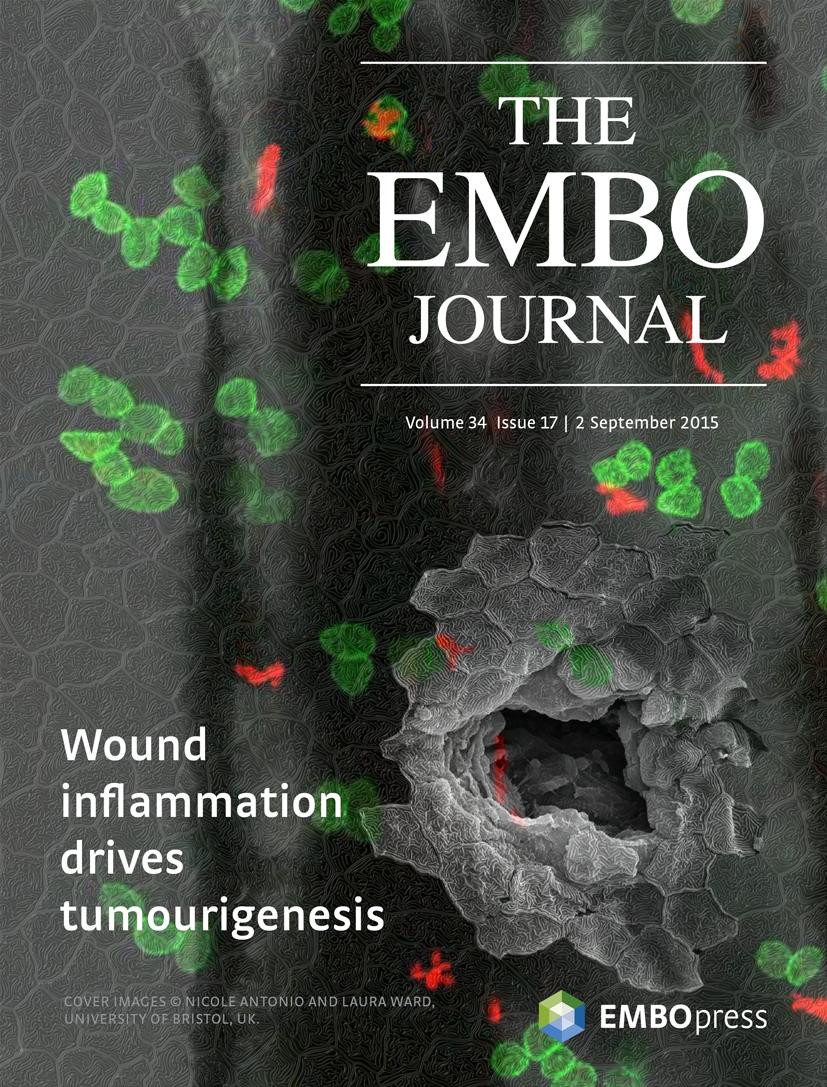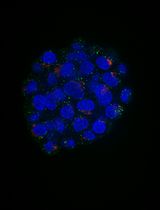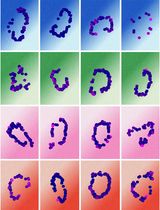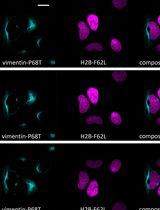- EN - English
- CN - 中文
Determination of Cellular Phosphatidylinositol-3-phosphate (PI3P) Levels Using a Fluorescently Labelled Selective PI3P Binding Domain (PX)
采用荧光标记选择性PI3P结合域(PX)测定细胞PI3P含量
发布: 2016年08月20日第6卷第16期 DOI: 10.21769/BioProtoc.1903 浏览次数: 8266
评审: Ralph BottcherShyam SolankiDiana Búzová
Abstract
The lipid Phosphatidylinositol-3-phosphate [PtdIns3P or PI(3)P] plays many membrane trafficking roles and is primarily produced by the Class III PI3K, VPS34. Determining the level of cellular PI(3)P however can be complex. Extraction of cellular lipids by methanol/chloroform can struggle to separate and identify distinct phospholipid species. Alternately mass spectrometry may be utilised but this requires significant set up of specialised equipment and time to utilise.
Use of a PI(3)P-binding-specific recombinant protein domain is a quick method for ascertaining cellular PI(3)P levels and can also allow visualisation of sub-cellular localisation. The PX domain of p40phox (herein referred to as PX) is very specific for PI(3)P over other phospholipid species (Kanai et al., 2001). However, expressing PX directly in cells can be problematic, as it will act in a dominant negative manner to bind and sequester PI(3)P with greater affinity than endogenous proteins, thus disturbing cellular pathways and the normal balance of PI(3)P levels. Using fluorescently labelled PX following cell fixation is therefore more suitable, as it is able to highlight PI(3)P rich structures without risk of perturbing the system.
Background
Materials and Reagents
- ZebaTM spin desalting column (Thermo Fisher Scientific, catalog number: 89891 )
- 22 x 22 m cover glasses, Menzel Glaser (VWR, catalog number: 631-1336 )
- Millex-GS syringe filter unit, 0.22 µm (Merck Millipore, catalog number: SLGSV255F )
- Slide-A-Lyzer dialysis cassettes, 10K MWCO 12 ml (Thermo Fisher Scientific, catalog number: 66810 )
- Microscope slides, 75 x 25 mm (superfrost) (VWR, catalog number: 48311-600 )
- BL-21 bacteria (New England Biolabs, catalog number: C2530H )
- U2OS cells (ATCC, catalog number: HTB-96 )
- SOC medium (Thermo Fisher Scientific, catalog number: 15544034 )
- LB broth, Miller (Merck Millipore, catalog number: 71753 )
- LB agar, Miller (Merck Millipore, catalog number: 1102835000 )
- Ampicillin
- IPTG (Sigma-Aldrich, catalog number: I6758 )
- Tris (VWR International, catalog number: 103157P )
- Sodium chloride (NaCl) (VWR International, catalog number: 27810.364 )
- Triton X-100 (Fisher Scientific, catalog number: BP151-500 )
- β-mercaptoethanol (Sigma-Aldrich, catalog number: M6250 )
- PMSF (Sigma-Aldrich, catalog number: P7626 )
- Benzamidine (Sigma-Aldrich, catalog number: 12072 )
- Brij-35 (Merck Millipore Corporation, catalog number: 1.01894.1000 )
- EGTA (Sigma-Aldrich, catalog number: E4378 )
- Glutathione sepharose 4B (GE Healthcare, catalog number: 17-0756 )
- InstantBlue Coomassie stain (Expedeon, catalog number: ISB1L )
- Alexa Fluor 488 TFP ester (Thermo Fisher Scientific, catalog number: A37570 )
- Alexa Fluor 594 NHS ester (Thermo Fisher Scientific, catalog number: A37572 )
- Paraformaldehyde (Sigma-Aldrich, catalog number: P6148 )
- HEPES (ForMedium, catalog number: HEPES10 )
- Potassium chloride (KCl) (VWR International, catalog number: 26764.260 )
- Magnesium acetate (MgAc) (Sigma-Aldrich, catalog number: M5661 )
- Potassium glutamate (Sigma-Aldrich, catalog number: G1501 )
- DMEM (Thermo Fisher Scientific, Gibco®, catalog number: 11960-044
- PBS pH 7.4 (Sigma-Aldrich, catalog number: P4417 )
- Bovine serum albumin fraction V (BSA) (Sigma-Aldrich, catalog number: 10735108001 )
- Liquid nitrogen
- Sodium bicarbonate (Sigma-Aldrich, catalog number: S5761 )
- DMSO (Sigma-Aldrich, catalog number: D8418 )
- Glycerol, ultra pure (VWR, catalog number: IC800688 )
- Sucrose (Sigma-Aldrich, catalog number: S8501 )
- Sodium azide (Sigma-Aldrich, catalog number: S2002 )
- ProLong gold antifade mountant with DAPI (Thermo Fisher Scientific, catalog number: P36931 )
- Lysis buffer (see Recipes)
- Equilibration buffer (see Recipes)
- Wash buffer (see Recipes)
- Elution buffer (see Recipes)
- Dialysis buffer (see Recipes)
- Formaldehyde (see Recipes)
- Glutamate buffer (see Recipes)
- DMEM + HEPES (see Recipes)
- PBS + BSA (see Recipes)
Equipment
- Water bath
- Bacterial Shaker (e.g., Infors HT)
- Benchtop Centrifuge (e.g., Beckman Coulter, model: Allegra X-12R )
- Centrifuge (e.g., Beckman Coulter, model: Avanti J-26 XP )
- Sonicator (e.g., Sonics Vibra Cell)
- Tweezer
- GSH-Sepharose beads
- Magnetic stir bar (Fisher Scientific)
- Gel electrophoresis equipment (e.g., Dual minislab, model: ATTO AE6500 )
- Fluorescence microscope (e.g., Nikon Eclipse Ti-E model equipped with appropriate filter set for Alexa-Fluor dye)
Procedure
文章信息
版权信息
© 2016 The Authors; exclusive licensee Bio-protocol LLC.
如何引用
Munson, M. J. and Ganley, I. G. (2016). Determination of Cellular Phosphatidylinositol-3-phosphate (PI3P) Levels Using a Fluorescently Labelled Selective PI3P Binding Domain (PX). Bio-protocol 6(16): e1903. DOI: 10.21769/BioProtoc.1903.
分类
细胞生物学 > 细胞染色 > 脂质
细胞生物学 > 细胞成像 > 荧光
生物化学 > 蛋白质 > 标记
您对这篇实验方法有问题吗?
在此处发布您的问题,我们将邀请本文作者来回答。同时,我们会将您的问题发布到Bio-protocol Exchange,以便寻求社区成员的帮助。
提问指南
+ 问题描述
写下详细的问题描述,包括所有有助于他人回答您问题的信息(例如实验过程、条件和相关图像等)。
Share
Bluesky
X
Copy link












